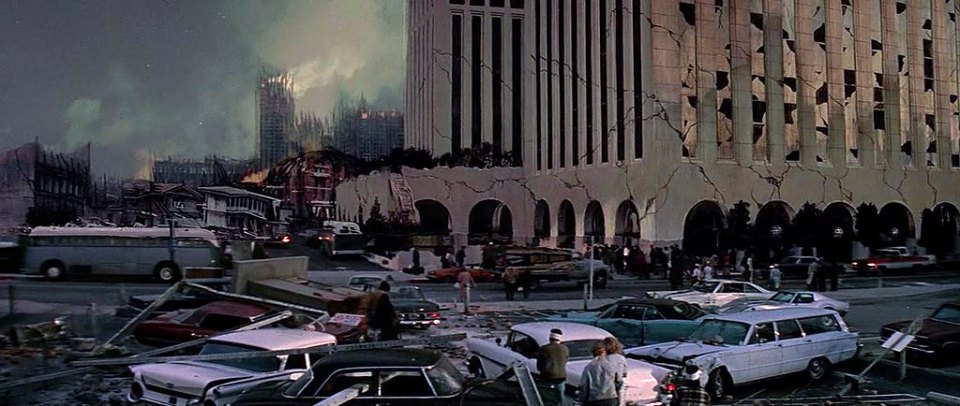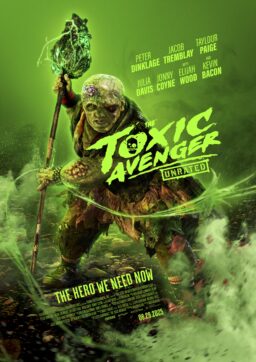A recent viewing of all my old 1970s disaster movie DVDs has led me to conclude that Mark Robson’s “Earthquake” (1974) is a film worth discussing, even if it is clearly far from the best of its genre. The movie was a critical disappointment when it came out and Leonard Maltin’s Guide went as far as to assign a “Bomb” rating. Still, there are too many cinematic lessons to be learned from a movie like “Earthquake” to ignore.
“Earthquake” was made by producer Jennings Lang, the man behind the “Airport” movies. It is mostly remembered for having been released with the Academy Award-winning, ground breaking, Sensurround system which basically consisted of placing a gigantic subwoofer in theaters, causing all sorts of havoc such as falling chunks of plaster, nose bleeds in audience members and unwelcome trembling in adjoining theaters at multiplexes. All for a process that was to be used in only three later movies (“Midway,” “Rollercoaster” and “Battlestar Galactica”). Come to think of it, a few weeks ago I dozed off while watching the new “Jumanji” movie at a theatre and was rudely woken up by the noise from the theater next door which was showing a movie in 4D; for a moment I truly thought we were going through a real earthquake. Thus, I think it’s safe to say that 4D has been the closest I’ve come to re-experiencing Sensurround.
“Earthquake” was mostly structured like an average disaster film of the 1970s. Several interlocking characters are introduced early and, unlike the recent entries of the genre such as “San Andreas” (2015) and those by Roland Emmerich, their attitude towards the catastrophe in hand was dead serious, leaving very little room for humor. Our film deals with the world class engineer Stuart Graff (Charlton Heston), whose marriage to Remy (Ava Gardner) is clearly on the outs, so much that it is impossible to imagine they could have ever been even remotely happy together. Remy is the daughter of Stuart’s boss Royce played by “Bonanza” patriarch Lorne Greene. With just a few hours before catastrophe strikes, Stuart starts dating widowed Denise (played by Genevieve Bujold). These are the basic dynamics of a cinematic love triangle that makes the one in Michael Bay’s “Pearl Harbor” (2001) feel like the one in Michael Curtiz’s “Casablanca” by comparison.
I don’t believe the general outline of “Earthquake” is by any means terrible, even if it’s not particularly original for an entry that debuted right in the middle of the 1970s disaster movie craze, which itself is like a shorter-lived version of today’s comic book epidemic. The characters are first introduced, followed by a small tremor detonates the usual warnings that go unanswered and the big earthquake destroys the city in spectacular fashion. The Heston/George Kennedy duo then proceeds to rescue several extras in heroic fashion, while the bursting of a dam provides the opportunity for a spectacular watery escape, reminiscent of the one in “The Poseidon Adventure” (1972) and even that in 1978’s “Superman” (also penned by screenwriter Mario Puzo). All that’s missing from the typical entry of this genre are the usual warnings against greed as the source of Man’s doom and a character spontaneously bursting into song. I suppose the filmmakers just couldn’t find the right spot.
On the plus side, the movie has some terrific special effects, especially those involving the progressive destruction of Los Angeles in miniature (as seen from Royce’s office) as well as some falling vehicles from a collapsing freeway (here’s a hint: if you are driving during an earthquake, it may not be a bad idea to hit the brakes!). These types of effects have more weight and end up being more convincing than most of those made with CGI these days. The film’s technicians came up with some of the most incredibly looking models, on par with those from the ship in “The Poseidon Adventure” and the skyscraper from “The Towering Inferno.”

The first of “Earthquake’s” main faults is that it also happens to include some really shabby manual effects, particularly those that involve real sized elements. If there is one thing I’ve never seen in a real earthquake it’s flying columns, beams and signs falling in the middle of the street. By relying so heavily on the Sensurround system during “The Event,” in many instances the filmmakers forgot to include the necessary sound effects to go along with their collapse or their rupture, making it hard to avoid the fact they are mostly made out of Styrofoam. There’s also the hilarious shot of the woman with shards of glass stuck in her face, even before a glass pane falls on her head. “Earthquake” includes some other laughable sequences such as the one involving a cook falling alongside a stove at the precise moment when a giant boiling pot falls and empties all of its contents on top him (that image looks just like something out of the “World’s Dumbest Videos” TV show). Even worse is the visual of guy looking for gas leaks with a cigarette in his mouth. Smokers have routinely been treated rather harshly in movies (think of the man who loses his arm to a shark in “Deep Blue Sea”) but even as a warning on how not to encounter this type of situation, the image here is beyond stupid.
The film’s second mistake was including too many scenes and characters that just don’t belong. Did a disaster movie really need a sequence involving a motorcycle stunt show or a car chase that includes the requisite baby carriage and Zsa Zsa Gabor’s prized gardens? Did it really need a bar fight with drunks smashing into racks full of pool sticks? And what exactly could have been the point of filling any disaster entry with such an assortment of bizarre characters like the Marjoe Gortner sex deviate who looks as if he came right out of the “Pulp Fiction” sadomasochist basement? Also hard to explain are the presence of Gortner & Ava Gardner’s strange wigs and Gortner & Victoria Principal’s matching perms. I suppose it’s no mystery that anything and everything from the 1970s has dated horribly (think of Charton Heston’s “portable” car phone and his ever-moving toupee) but these examples seem to have been done fully on purpose. Then there’s Walter Matthau’s prolonged drunken cameo, which seems to rely on the old “funny by repetition” trick. In other words, he just gets more annoying by the minute.
A special mention in the film’s main problems has to go to the Ava Gardner & Charlton Heston relationship. It’s safe to say that screenwriter Mario Puzo has done a better job writing about human relations in his other films. The problem is not so much that Gardner’s screen father is only seven years older than her, (after all, Sean Connery was only 12 years older than his Harrison Ford son in “Indiana Jones and the Last Crusade”) but there’s something intrinsically odd about Gardner calling Lorne Greene “Daddy” that makes it impossible not to snicker. She plays her part as if she had seen Elizabeth Taylor in “Who’s Afraid of Virginia Woolf?” a few too many times and remains insufferable from start to finish. At the end of the day, basing the film’s emotional closure on the sacrificing of Charlton Heston’s life for someone so utterly unpleasant made for the film’s biggest weakness. I’m aware of how a similar approach with the Gene Hackman character brought weight to “The Poseidon Adventure’” conclusion but perhaps director Robson could have included a flashback of happier times or at least provide any hint whatsoever of why Heston should have ever sacrificed certain happiness, at least two sides of this film’s love triangle.

Most of the shortcomings mentioned here derive from a lack of conviction and the love of the game that could always be felt in the works of Irwin Allen, even though he eventually simply ran out of worthy stories of catastrophe. Instead of going for broke by casting a smashing duo the likes of Steve McQueen and Paul Newman in “The Towering Inferno” Jennings Lang settled with the very ordinary Heston /Kennedy duo from “Airport 1975” (all that’s missing here is the usual “Airport” tagline “… and George Kennedy as Patroni”!). The simple comparison of the posters from these two movies speaks volumes about their respective ambitions. Both share the same type of disaster artwork as well as images of their characters boxed in the small squares both while “The Towering Inferno” includes them in all sorts of emotional expressions and tags them with the grandiose likes of “The Fire Chief!, The Architect!, the Builder! (and the female leads with the more modest The Girlfriend! the Wife! The Widow!”) All we get in “Earthquake” are the expressions of a group of actors yet again going through the motions.
“Earthquake” was originally promoted using the ambitious slogan “An Event… ”; needless to say it didn’t fully live up to that hype. Oddly enough, attending “Earthquake” as a sixth grader when it opened here in Mexico on a Wednesday in 1975 was one of those rare times where I couldn’t get in the theater during my first couple of tries, as scalpers managed to grab all the tickets for the opening day shows. But while I suppose the film was never really worth such an effort, I have to admit I still can’t help but smile at such moments as when Genevieve Bujold’s holds to a tree for dear life while her beer & chicken-eating neighbor slides down a cliff, followed by all of his possessions (and his still-supported home!), or even at the very amateurish way director Robson conveys the carnage after some elevator passengers fall to their doom, by splattering drops of fake blood on the camera lens. After all these years it’s hard for me to say if “Earthquake” is either a guilty pleasure or a movie so bad that it’s good. Perhaps the line between both attributes is too thin, or maybe they are one and the same.












